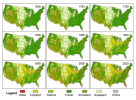I'd like to use the CESM-LME transient land forcing files to show how the fraction of US crops and pastures has changed over time, but am not sure what variables to use (e.g., LANDFRAC_PFT, PCT_PFT). I am looking at the files listed in Table 5 on the LME Instructions page (Last Millennium Ensemble Project Insructions).
Any advice would be much appreciated, thanks.
Any advice would be much appreciated, thanks.

